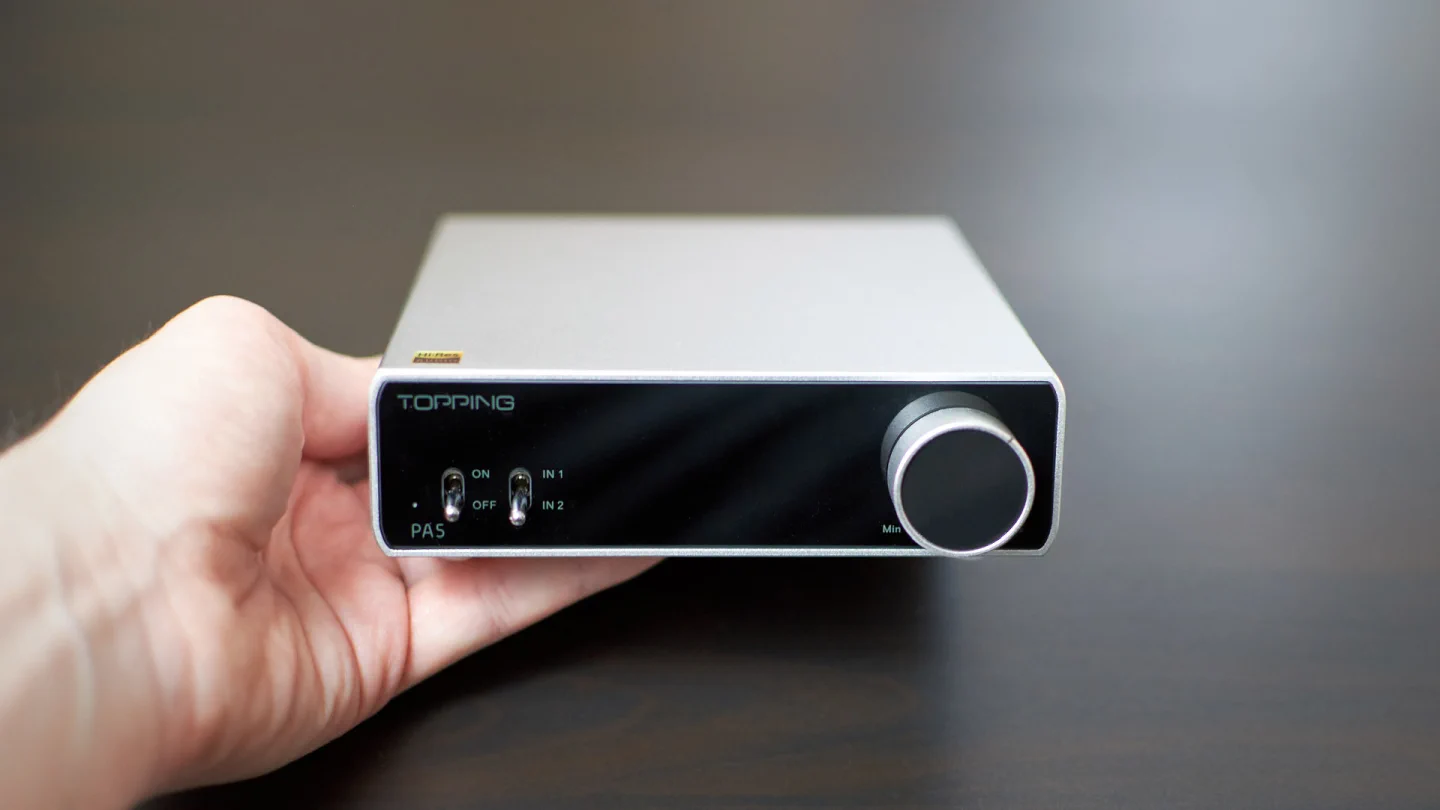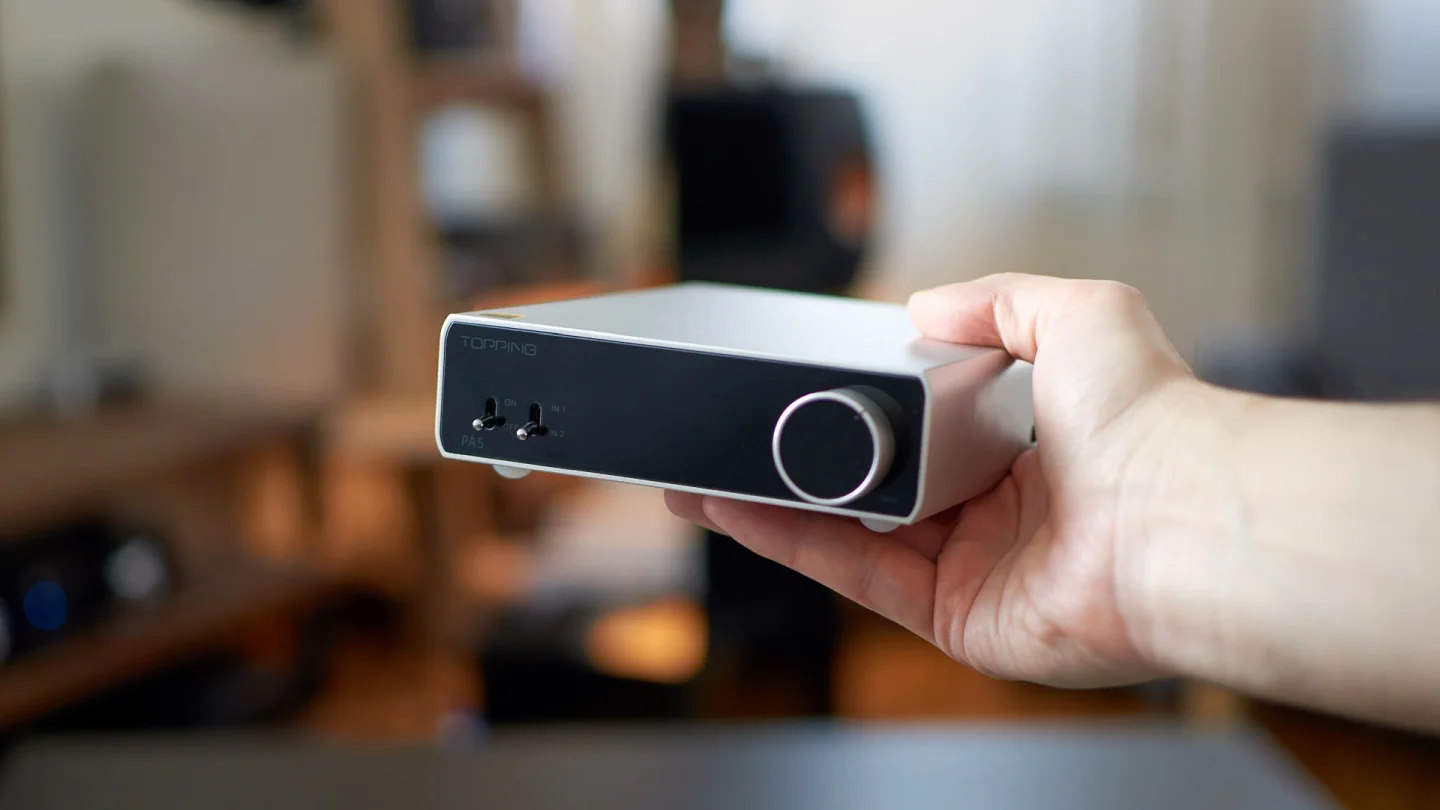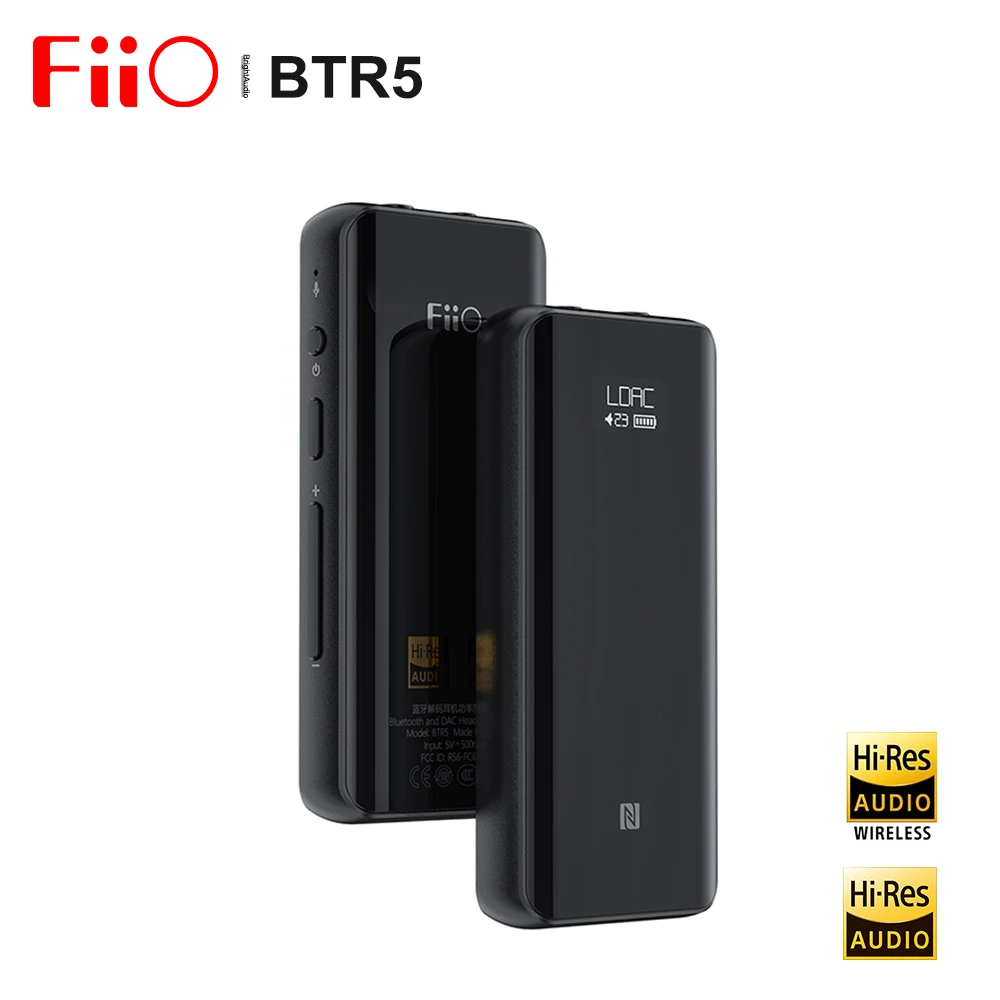Topping PA5 is the latest talk around the web, but what is it really and is all that hype really deserved? To put it simply, this is a small and simple integrated amplifier that can bring a lot of music for more than a reasonable amount of money. Keep reading to find out the details and is it a good buy for you and your system.
Features
I’ve noticed that many people call Topping PA5 a power amp, but in my book, if it has a volume control, no matter how simple it is, I consider it to be an integrated amplifier. So moving forward I’ll treat it as such. That said, PA5 is probably one of the most simplistic integrated you’ll encounter on the market. It does have a volume control, but it doesn’t offer remote control. It also has only two analog inputs, both of which are balanced and in a form of TRS jacks. I do prefer to see full-sized XLRs here but in such a small space that was simply not an option. Even speaker cable binding posts are miniature. Those will accept traditional 4mm banana plugs, as well as smaller spades or bare wire that shouldn’t be much thicker than 1.5 mm2 (AWG 16), but I suppose you could fit 2.5 mm2 (AWG 14) if you’re willing to thin out the ends of the wires a bit. To make the amplifier itself this small, Topping decided to put the power supply out of the main unit and inside the fairly big power brick. This approach has both its pros and cons, but that talk would run too deep and technical for the purpose of this write-up.
The front panel is again very simple with two switches and a volume knob. One of the switches is used to turn the unit on and off, while the other one is to select between the two analog inputs. Volume attenuation is done in a very traditional way by using an Alps potentiometer. That’s it, there are no bass or treble controls, digital inputs, subwoofer output, or any other extras. If that’s putting you down, then you should probably look into a different model, but if you’re still here then keep on reading cause there is a positive side to all this.

Power and Gain
If you were to open any of the online stores offering this amp, probably the first power rating you would see is 140 Watts. While not exactly a lie, this is a power that PA5 can give when connected to a 4 Ohm speaker and with a very high distortion of 10%. That kind of power rating can be OK for a cheap micro stack but it’s no way to go for a proper peace of Hi-Fidelity gear. So we’ll stick to the one stating 65 Watts into 8 Ohm with distortion less than 1%. But hey, that’s not bad at all either, it’s actually plenty for most reasonably sensitive speakers. I lived most of my audiophile life with similarly rated amps. Up until recently, I was using a Hegel H90 amplifier that offers 60W per channel.
Another part of the story is gain. I’m not sure if everybody knows this but gain is measured in decibels, and it tells you how much will the amp amplify the signal you feed it with. In the case of Topping PA5, we’re talking about the rather modest number of 19 dB. Now add to that the fact that the rated sensitivity of its analog inputs is 5 Volts (some DACs output 5V but most will provide 4V) and you’ll get to the conclusion that some pairing attention is needed to get the best out of this little guy. But I’ll talk a little bit more about this in the pairing section.
Sound
To put it simply, Topping PA5 is a respectable performer. It didn’t take much to notice how capable it is when it comes to detail retrieval. Tiny details in the recording are easily noticeable, for example, a singer taking a breath in front of the microphone, background percussions, etc. This character is equally present throughout the whole frequency spectrum. The bassline is disciplined, striking with intent, and never losing grip over a note. Move to the upper bass and nothing changes, it’s very tidy and texture retrieval is quite admirable too. Midrange simply continues in a similar fashion, offering clear and crisp edges. Instruments sound present and well defined, vocals too. Listening to one of my favorite singers – Leonard Cohen – I could really appreciate the way that amplifier handles his chesty but raspy vocal. At no time did PA5 add excessive lispiness or robbed it of its natural fullness, but it didn’t add any warmth or make it sound euphonic either. This is basically the way that PA5 deals with every tone – informative, present, well-textured – but if you’re looking for any sort of warmth, euphony, or sweetness, better keep looking because you won’t find it here.
Moving away from the tonality and to the soundstage, things are good. Topping PA5 develops a decently spacious and airy soundstage. Instruments are well separated and nicely layered, secured into their positions on the soundstage without ever overlapping and suffocating each other. The depth of the soundstage is very well presented, and if a recording was made inside of some sort of hall or church, you’ll hear those deep echoes quite nicely. While audiophiles with very capable amplifiers might feel that this should be a given, this quality is not that often achieved with gear of this price. Take any traditional, big brand amp of 300-400USD and you’re probably going to hear just a rough idea of the positioning inside of the soundstage, with instruments being hazy and not as nearly well defined and pinpointed. But I’ll talk more about it in the comparison section.
Finally, talking about dynamics and slam, a small PA5 doesn’t disappoint, it’s a fast-paced, lively sounding amp for sure. The bassline is more on the nimble and fast side of things so sheer slam and punch are not the strongest suits of this amp. Truth be told, it’s not that any other amp at this price point is doing much better on this front. Overall energy and dynamics are just fine, and simply in line with what you can expect from a reasonably powered sixty watts amplifier.

Pairing
All of the above taken into the account, I believe that Topping PA5 will be on its best behavior if paired with slightly fuller and juicier sounding speakers of a decent sensitivity. Wharfdale’s offering comes to mind, for example. Most KEFs from the Q series would be a nice match too. I would however avoid dry-sounding speakers such as Monitor Audio because I believe that would sound too dry and analytical for most listeners.
Finally, talking about the sheer power, I feel there’s enough of it even with low-sensitivity speakers if you don’t expect party-level volumes. For example, using PA5 with KEF LS50 that’s just 85 dB in sensitivity and likes to be driven hard, provided a very decent experience. Most of the time I had all the juice I could wish for normal listening levels in my 4.4 by 7 meters room (15 by 23 feet). But just occasionally I stumbled upon some sort of classical music peace with a very low average recording volume that made me crank the PA5 almost to the max. Bear in mind that I was using a DAC with 4 Volts output, and that’s why I strongly recommend using a DAC with balanced outs. Any sort of single-ended to balanced adapters would leave you with half of the signal and maybe leave you wanted for more gain than this amplifier can provide.
Comparisons
SMSL DA-9 is another dirty cheap but very capable little amplifier. It offers a somewhat warmer and fuller bassline, but with less control and authority. PA5 sounds tidier but a bit drier in that upper bass section. Topping sounds more present and crisp in the midrange too, with somewhat better separation and layering. I do feel that Topping has an edge when it comes to the overall sonic performance but SMSL counters that with more features, so you do get a remote, tone controls, both balanced and single-ended inputs… and all of that at a lower price point. Not an easy choice.
NAD D3020 V2 is slightly more expensive but packs an integrated DAC, phono input, sub out, remote, and bass boost. So speaking about features, NAD takes this fight easily. But when it comes to the sheer sound fidelity, Topping is in a league of its own. Yes, it is definitely much drier sounding and the contrast is even bigger because of the NAD’s overly warm and dark presentation. But tonality aside, PA5 is a much more precise tool that follows rhythm on a dime and digs details that would simply melt and be lost with NAD. PA5 is also capable of such fine layering and pinpointing of every instrument that NAD can’t even come close to arranging such a precise soundstage.
Hegel H90 is a much bigger amplifier with the whole digital section and a streamer of a really high quilty. So here I’ll just focus on its analog amplification section for the sake of putting PA5’s performance into perspective. These two amps are on roughly the same level. Hegel sounds tonally smoother and calmer, with the soundstage laid back behind the speakers. Topping is more forward and aggressive, especially in the midrange. It’s not as smooth and liquid sounding as Hegel but it can sound livelier and as if it can retrieve even more tone texture. I don’t think that either of these is inherently superior. Preferring one or the other tonality would come down to your own preference, as well as matching with the rest of your system.
Conclusion
Topping PA5 is a peculiar product and as such it’s certainly not for everyone. The lack of remote control and single-ended inputs will alienate some people for sure. But if paired with care, this amplifier can provide sonic fidelity that surpasses most of its big brand’s peers at this price point. So if getting the highest possible sound fidelity at the lowest price possible is a priority, and you don’t care much about missing features, Topping PA5 comes highly recommended.
Update: The score was readjusted to lower values due to the SMSL A300 arrival.
| TOPPING PA5 – CHARACTERISTICS |
|
Output power: |







Pozdrav,
Kupio sam Elac debut reference dbr62, max 120w na 6ohma pa me zanima da li bi ovo pojacalo bilo preslabo za te zvucnike? I da imate kakvu bolju preporuku? Ps. Jos sam gledao loxjie l, a30, ali i ono je relativno ‘slabo’ 2x80w na 4 ohma.
Ne bi trebalo da bude slabo za neke umerene glasnoće ali ako baš voliš da prodrmaš komšije onda baš i nije neko rešenje.
Do you know how many of these amps fail? Lots. Yand, and the weasel Amir, his mouthpiece are even too scared to answer complaints at ASR.
Hi Ron, I’ll have to check that out. My unit is still alive and rocking, but to be honest I don’t use it often. Reliability is a very tough one to assess in reviews like this one because I used it for a week or so and then went back to my regular amplifier. I still use it sometimes for comparisons and stuff but that’s still a very low mileage.
Pozdrav,
Sta mislite o kombinaciji Pa5 sa Hidizs dh80 dacom, za hifi slusanje na zvucnicima normalno, hvala
Pozdrav, iako nisam lično baš tu kombinaciju isprobao trebalo bi da bude jako dobra. PA5 je super detaljan, brz… A DH80s vrlo punog i prirodnog zvuka bez trunke napadnosti. Zajedno bi trebalo da se slože baš lepo.
Topping apparently wants to give up on the PA5 and is developing the PA7 which probably addresses the reliability problem. The PA5 provides so much for such a reasonable price that I was seriously considering pulling the trigger hoping my luck would hold. But the PA7 (maybe will be released under another name) should set everything right.
Do you think it is a little unfair comparing the £200 topping to the £1500 heigel
I’m not using that comparison to put down Topping but to provide a clear picture of how it sounds, what are its qualities, and where are the limits.
Growing up I was somewhat annoyed that no mainstream magazine ever did that because I never new what would I get with spending more money.
I particualrly like these review because they make comparisons with cheap and expensive products. I too am disappointed that mainstream magazines, who have vested interests, do not do that. Why, you might ask… I think it’s a form of corruption.